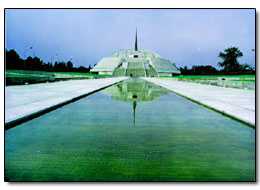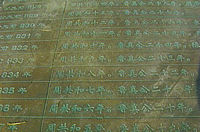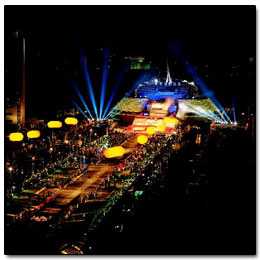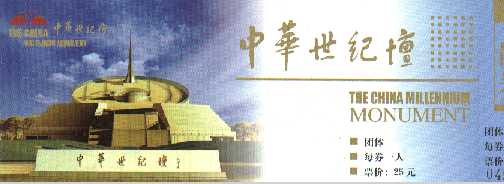 The China Millennium Monument, as China's symbolic and commemorative building to welcome the Year 2000, is a gift for the world of the 21st century from the Chinese people, forever standing in China's capital Beijing. The China Millennium Monument, as China's symbolic and commemorative building to welcome the Year 2000, is a gift for the world of the 21st century from the Chinese people, forever standing in China's capital Beijing.
The China Millennium Monument stands along a north-south axis between the Military Museum and the Central Television Complex, with the scenic Yuyuantan Park to the north and the West Beijing Railway Terminus to the south, occupying an area of 4.5 hectares and a total floor space of about 42,000 square metres.
The Monument is a grand structure ingeniously combining the spirit of traditional Chinese culture with modern architectural art, and integrating architecture, landscaping, sculpture, mural painting, and various other art forms. It will not only be an eternal memory of the turn of the millennium, but also serve as a centre for cultural, artistic, and scientific exhibitions both at home and abroad, as well as an inspiration in patriotism.
 inside the southern entrance to the Monument is the Plaza of Holy Fire, one metre below ground and 960 square metres in area, standing for China' s vast territory of 9,600,000 square kilometres. With the gentle centripetal rise of the ground suggesting the rise of the Chinese nation, the Holy Fire of China is located right in the middle of the Plaza. The fire originated at the site of Peking man at Zhoukoudian, Beijing, and is fed on natural gas. The everburning flames, rising some 45 centimetres high, are a token of the unceasing creativity of the Chinese civilization. inside the southern entrance to the Monument is the Plaza of Holy Fire, one metre below ground and 960 square metres in area, standing for China' s vast territory of 9,600,000 square kilometres. With the gentle centripetal rise of the ground suggesting the rise of the Chinese nation, the Holy Fire of China is located right in the middle of the Plaza. The fire originated at the site of Peking man at Zhoukoudian, Beijing, and is fed on natural gas. The everburning flames, rising some 45 centimetres high, are a token of the unceasing creativity of the Chinese civilization.
Along both the eastern and western side of the plaza, there is a steady current of water cascading down the steps, reminding the visitor of the mother rivers of the Chinese nation: the Yangtze and Yellow Rivers.
 Going up the northern steps, the visitor sees a 270-metre-long causeway. The 3-metre-wide bronze plates paved along the middle of the causeway are carved in a south-north order with a chronology describing man's progress from his first appearance three million years ago to 2000 AD, and succinctly recounting important events of Chinese history in science and technology, culture, education and other fields, illustrated by the Ten Heavenly Stems and the Twelve Earthly Branches with their corresponding symbolic animals. These immobile bronze inscriptions are incessantly caressed by a limpid sheet of running stream, with the movement of the water and the stillness of the pavement harmonizing and contrasting with each other to indicate the continuity and renewal of the nation' s history. Strolling along the causeway, the visitor seems to be passing through China' s five millennia, witnessing her continuous civilization and savouring her distinctive uniqueness. Going up the northern steps, the visitor sees a 270-metre-long causeway. The 3-metre-wide bronze plates paved along the middle of the causeway are carved in a south-north order with a chronology describing man's progress from his first appearance three million years ago to 2000 AD, and succinctly recounting important events of Chinese history in science and technology, culture, education and other fields, illustrated by the Ten Heavenly Stems and the Twelve Earthly Branches with their corresponding symbolic animals. These immobile bronze inscriptions are incessantly caressed by a limpid sheet of running stream, with the movement of the water and the stillness of the pavement harmonizing and contrasting with each other to indicate the continuity and renewal of the nation' s history. Strolling along the causeway, the visitor seems to be passing through China' s five millennia, witnessing her continuous civilization and savouring her distinctive uniqueness.
The causeway is lined on either side with a 16-metre-wide belt of verdant lawns and hedges made up of Xian juniper, Jinshan meadowsweet, purple-leaf barberry and golden-leaf privet, showing with the rotation of the seasons the infinite changes and beauty of lively nature, and providing much pleasing and peaceful space for the roaming of the mind.
The main structure of the Monument, consisting of "qian" (or heaven) and "kun" (or earth), stands 28 metres high and 85 metres in diameter.
 The "qian", or the revolving rotunda, is 47 metres in diameter, slopes upwards at an angle of 19.4 degrees and revolves once every 3-12 hours. The outer wall of the "qian" is carved with 56 ethnic designs in relief, representing the 56 ethnic groups of the Chinese nation in their unity and solidarity. The round, level space at the middie of the rotunda, 14 metres in diameter, may serve as a central stage for large-scale, open-air celebrations and/or performances of song and dance, symphonic music, or other art and cultaral forms. The steps all around can hold over a thousand spectators. Piercing into the sky from the "qian" is a 27.6-metre-long needle, a symbol of the infinity of time and space. The "qian", or the revolving rotunda, is 47 metres in diameter, slopes upwards at an angle of 19.4 degrees and revolves once every 3-12 hours. The outer wall of the "qian" is carved with 56 ethnic designs in relief, representing the 56 ethnic groups of the Chinese nation in their unity and solidarity. The round, level space at the middie of the rotunda, 14 metres in diameter, may serve as a central stage for large-scale, open-air celebrations and/or performances of song and dance, symphonic music, or other art and cultaral forms. The steps all around can hold over a thousand spectators. Piercing into the sky from the "qian" is a 27.6-metre-long needle, a symbol of the infinity of time and space.
The "kun", or the immobile bottom of the structure, has on its outside sixteen circular tiers of steps paved with light-tan granite slabs, and in its interior e-metre-wide circular galleries totaling 140 metres in length and housing bronze statues of forty most outstanding figures in Chinese history. Passing by the statues, the visitor may watch the 56 ethnic designs inscribed on the outer wall and witness the revolution of the "qian" at the same time.
The still circular galleries and the revolving rotunda symbolise the time-honoured Chinese concepts of "qian" and "kun", which are best summed up in the Book of Changes: "As heaven moves constantly, so the superior man should rely on himself and work ceaselessly. As the earth extends infinitely, so the superior man should embrace all with magnanimous virtue." "Qian" refers to the eternal, ceaseless movement of celestial bodies, embodying an idea of eternal edification, endeavour and progress, while "kun" stands for the all-embracing earth, displaying a spirit of tolerance, magnanimity and harmony.
The main structure as a whole, combining a harmony of movement and stillness with a grandeur of conception, manifests the Chinese nation's great spirit of ceaseless endeavour, as well as her broadminded emphasis on virtue and tolerance.
The Century Mural Hall, 38 metres in diameter and 1171 square metres in area, is decorated on the interior with a huge mural painting 4.8 metres high and 117 metres in periphery, making up 588 square metres - a record of its kind in the country. This mural depicts chronologically the evolution, spirit and achievements of the 5000-year-long Chinese civilization in four periods. It is a joint effort made by famous artists of the nation to reflect the highest level of contemporary Chinese mural painting and the profound cultural significance of the China Millennium Monument.

2001 ticket, admission 25 RMB
China Millennium Monument appears on the following banknote(s):
| |